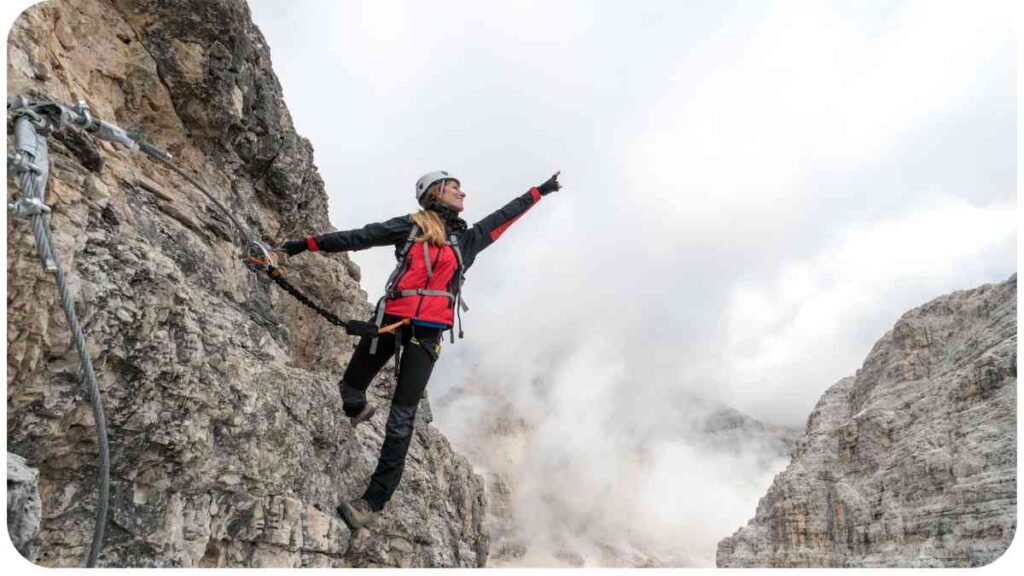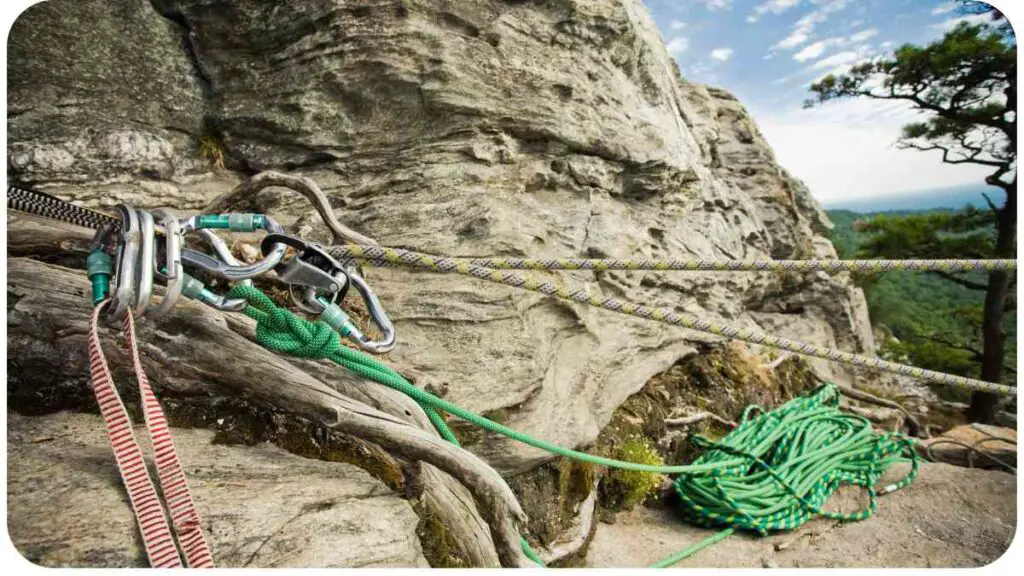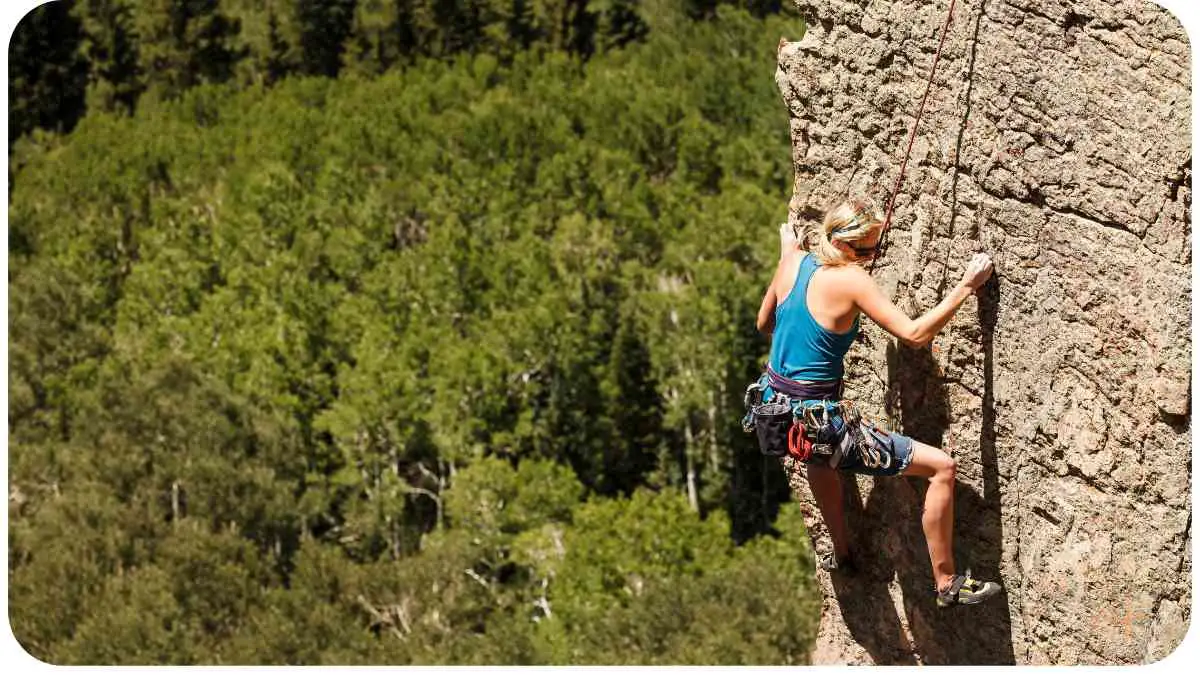Welcome to our guide on belaying issues and how to solve common problems for climbing safety. Belaying is a crucial skill in rock climbing that ensures the safety of both climbers and belayers. However, various issues can arise during the belaying process, jeopardizing the safety of everyone involved.
In this article, we will explore these problems and provide you with effective strategies to overcome them. Drawing from our extensive experience in the field, we will share insights, tips, and anecdotes to help you become a proficient and safe belayer.
| Takeaways |
|---|
| – Identify and mitigate risks beyond the basics of climbing safety. |
| – Pay attention to route identification to avoid potential hazards. |
| – Understand the challenges related to falls and take necessary precautions. |
| – Be aware of the impact of climber fatigue and manage energy levels. |
| – Prioritize comprehensive safety measures for a secure sport climbing experience. |
Understanding Belaying
Before we dive into the common problems faced in belaying, it is important to understand the fundamentals of belaying. Belaying is the technique used to protect a climber during ascent and descent.
The belayer controls the rope, providing tension to catch falls and prevent the climber from hitting the ground. It is a position of great responsibility, and mastering belaying techniques is essential for both climber and belayer safety.
Uncover the thrilling world of extreme bouldering with breathtaking routes that defy belief. From dizzying heights to challenging terrains, explore the unknown and push your limits.
Common Belaying Issues
Issue 1: Incorrect Rope Handling
One of the most common issues in belaying is incorrect rope handling. Inadequately managing the rope can lead to tangles, excessive slack, or untimely catches. By following proper rope handling techniques, you can minimize these risks. Table 1 provides a quick reference guide on the do’s and don’ts of rope handling.
Table 1: Rope Handling Do’s and Don’ts
| Do’s | Don’ts |
| Keep the rope neat and untangled | Allow the rope to drag on the ground |
| Communicate with the climber to gauge rope length | Tug excessively on the rope |
| Maintain proper tension to catch falls | Slack off too much or do not take in enough rope |
| Keep a secure grip on the rope | Wrap the rope around your body or limbs |
| Use belay devices correctly | Run the rope through improper sections of the device |
Issue 2: Inadequate Communication
Effective communication between the climber and belayer is essential for a safe climbing experience. Misunderstandings or lack of clear communication can lead to accidents. Table 2 outlines effective communication tips that can help ensure a smooth and secure climbing process.
Ascend to new heights with confidence. Learn about the causes, symptoms, and effective remedies for altitude sickness, ensuring a safe and enjoyable climb. Prepare for the ascent and conquer mountain peaks.
Table 2: Effective Communication Tips
| Tips | Benefits |
| Establish clear signals for commands | Minimizes misunderstandings |
| Use simple, concise language | Allows for quick and accurate communication |
| Confirm understanding before proceeding | Ensures mutual comprehension and agreement |
| Maintain visual and verbal contact | Promotes continuous awareness and response |
| Share feedback and discuss concerns | Builds trust and strengthens teamwork |
Issue 3: Improper Anchoring Techniques

Anchoring is a critical aspect of climbing safety, and using improper techniques can compromise the stability of the belay system. It is important to master proper anchoring techniques to prevent accidents and ensure the safety of all climbers involved. Refer to Table 3 for a guide on anchoring do’s and don’ts.
Table 3: Anchoring Do’s and Don’ts
| Do’s | Don’ts |
| Choose solid and reliable anchor points | Rely on untested or weak anchors |
| Use proper anchoring equipment | Improvise with inadequate materials |
| Ensure redundancy in the anchor system | Neglect to backup anchor points |
| Regularly inspect and maintain anchors | Assume anchors are always secure |
| Seek professional guidance when in doubt | Neglect to learn proper anchoring techniques |
Issue 4: Inadequate Equipment Knowledge
It is crucial for climbers and belayers to have a comprehensive understanding of the equipment used in climbing. Insufficient knowledge about gear can result in improper usage, compromising safety. Table 4 provides essential equipment knowledge that every climber and belayer should possess.
Safeguard your descent by mastering common belay device issues. From proper techniques to troubleshooting, discover essential knowledge for a secure climb. Enhance your descent skills and conquer any climbing challenge.
Table 4: Essential Equipment Knowledge
| Equipment | Important Details |
| Harness | Correct fitting, proper buckling, and adjustment |
| Belay device | Suitable for the rope diameter, correct usage |
| Carabiners | Proper locking mechanism, strong and undamaged condition |
| Ropes | Suitable for climbing type, regular inspection and care |
| Helmets | Proper fit, reliable protection against head injuries |
| Anchors and slings | Quality, strength, and proper use |
Issue 5: Lack of Emergency Preparedness
In climbing, emergencies can occur unexpectedly, and being prepared can make a significant difference. Having a solid plan and being equipped to handle emergencies can help prevent accidents and mitigate risks. Refer to Table 5 for an emergency preparedness checklist.
Table 5: Emergency Preparedness Checklist
| Emergency Preparedness Steps |
| Familiarize yourself with the climbing area and potential risks |
| Carry a first aid kit with essential supplies |
| Learn basic first aid and wilderness rescue techniques |
| Have a clear emergency communication plan |
| Practice emergency scenarios and self-rescue techniques |
Overcoming Belaying Issues
Now that we have identified the common belaying issues, it’s time to explore ways to overcome these challenges and ensure climbing safety. Let’s dive into each issue and discuss effective strategies for solving them.
Prioritize comfort and safety on your climbing adventures by addressing helmet fit issues. Explore tips for a secure and comfortable fit, ensuring peace of mind on every ascent. Optimize your climbing gear for a worry-free climb.
Solving Issue 1: Proper Rope Handling Techniques
To address the problem of incorrect rope handling, it’s crucial to adopt proper techniques that promote safety and efficiency. Remember to keep the rope neat and untangled, avoiding any dragging on the ground.
Communication with the climber is key to gauge the appropriate rope length. Maintain proper tension to catch falls without slackening off too much or failing to take in enough rope. It’s essential to have a secure grip on the rope, avoiding any wrapping around your body or limbs. Lastly, familiarize yourself with the correct usage of belay devices to ensure smooth rope management.
Solving Issue 2: Effective Communication Strategies
Clear and effective communication is vital during belaying. Establishing clear signals for commands helps minimize misunderstandings. Use simple and concise language to facilitate quick and accurate communication.
Always confirm understanding before proceeding to ensure that both the climber and belayer are on the same page. Maintain visual and verbal contact throughout the climb for continuous awareness and a prompt response to any situation.
Additionally, it’s important to foster open communication, giving and receiving feedback, and discussing any concerns or uncertainties.
Solving Issue 3: Mastering Anchoring Techniques

Proper anchoring techniques are critical for the stability and safety of the belay system. Always choose solid and reliable anchor points, avoiding untested or weak anchors. Make sure to use appropriate anchoring equipment and ensure redundancy in the anchor system for added security.
Regularly inspect and maintain the anchors, never assuming they are always secure. If you have any doubts or lack experience, seek guidance from a professional to better understand and apply proper anchoring techniques.
Elevate your lead climbing skills with insights into common concerns and their solutions. From overcoming fears to mastering techniques, empower your climbing journey and face challenges with confidence.
Solving Issue 4: Gaining Equipment Knowledge
Equip yourself with comprehensive knowledge about climbing gear to ensure safe and proper usage. Understand the correct fitting and adjustment of harnesses, ensuring proper buckling. Familiarize yourself with different types of belay devices and use the suitable one for the rope diameter.
Learn about the locking mechanisms in carabiners and make sure they are in a strong and undamaged condition. Additionally, understand the characteristics and care requirements of ropes, helmets, anchors, slings, and other necessary equipment. Regularly inspect and maintain your gear to ensure its reliability and longevity.
Solving Issue 5: Developing Emergency Preparedness
Prepare yourself and your climbing partners for emergencies by being proactive and ready to handle unexpected situations. Familiarize yourself with the climbing area and potential risks, such as loose rocks or changing weather conditions.
Carry a well-stocked first aid kit with essential supplies and learn basic first aid and wilderness rescue techniques. Establish a clear emergency communication plan, including knowing the nearest exit routes and emergency contact information.
Regularly practice emergency scenarios and train in self-rescue techniques to build confidence and enhance your ability to handle critical situations.
Conclusion
In conclusion, belaying issues can compromise climbing safety, but by addressing these problems and implementing effective strategies, we can overcome them. Remember to prioritize proper rope handling, maintain effective communication, master anchoring techniques, gain comprehensive equipment knowledge, and develop emergency preparedness.
Through practice, training, and continuous learning, you can become a proficient and safe belayer. So don’t let these common issues hold you back; use the insights, tips, and guidance provided in this article to enhance your climbing experience and ensure a safe ascent and descent.
Further Reading
Here are some additional resources that you can explore to gain further insights into belaying and climbing safety:
- Common Mistakes in Belaying: Tips for Improving Climbing Safety – This article discusses common mistakes made in belaying and provides tips on how to improve climbing safety. It covers topics such as rope management, communication, and equipment handling.
Short description: Learn about the common mistakes to avoid in belaying and gain valuable tips for enhancing climbing safety. - Sport Climbing Safety: Lesser Thought-of Problems – This blog post explores the lesser thought-of problems in sport climbing safety. It highlights issues beyond the basics and provides insights on how to mitigate risks. The article covers aspects like route identification, falls, and climber fatigue.
Short description: Find out about the often overlooked safety concerns in sport climbing and discover practical advice for tackling them. - Belaying Beginner’s Guide – This comprehensive guide offers a detailed overview of belaying for beginners. It covers the fundamentals of belaying, including equipment, techniques, and safety protocols. The article also provides step-by-step instructions and tips for mastering the belay process.
Short description: Dive into a beginner’s guide to belaying and gain a solid understanding of the equipment, techniques, and safety practices involved.
FAQs
Here are some frequently asked questions about belaying and their answers:
Q: What is belaying in rock climbing?
A: Belaying is a technique used to protect a climber during ascent and descent. The belayer controls the rope to provide tension, catch falls, and prevent the climber from hitting the ground.
Q: What are the essential skills required for belaying?
A: Essential skills for belaying include proper rope handling, effective communication, mastering anchoring techniques, comprehensive knowledge of equipment, and developing emergency preparedness.
Q: How can I improve my rope handling skills?
A: Improving rope handling skills requires practicing techniques such as keeping the rope neat, maintaining proper tension, and using belay devices correctly. Clear communication with the climber is also vital.
Q: What should I consider when choosing anchor points?
A: When choosing anchor points, consider their strength and reliability. Avoid relying on untested or weak anchors, and ensure proper redundancy in the anchor system.
Q: Is emergency preparedness important in climbing?
A: Yes, emergency preparedness is crucial in climbing. Being prepared for unexpected situations includes familiarizing yourself with the climbing area, carrying a first aid kit, learning first aid and rescue techniques, and having a clear emergency communication plan.

Welcome to my blog! I’m Hellen James, and I’m incredibly passionate about rock climbing, bouldering, ice climbing, and mountaineering. Join me as I embark on thrilling adventures, conquer vertical challenges, and share my experiences and insights with fellow outdoor enthusiasts.


